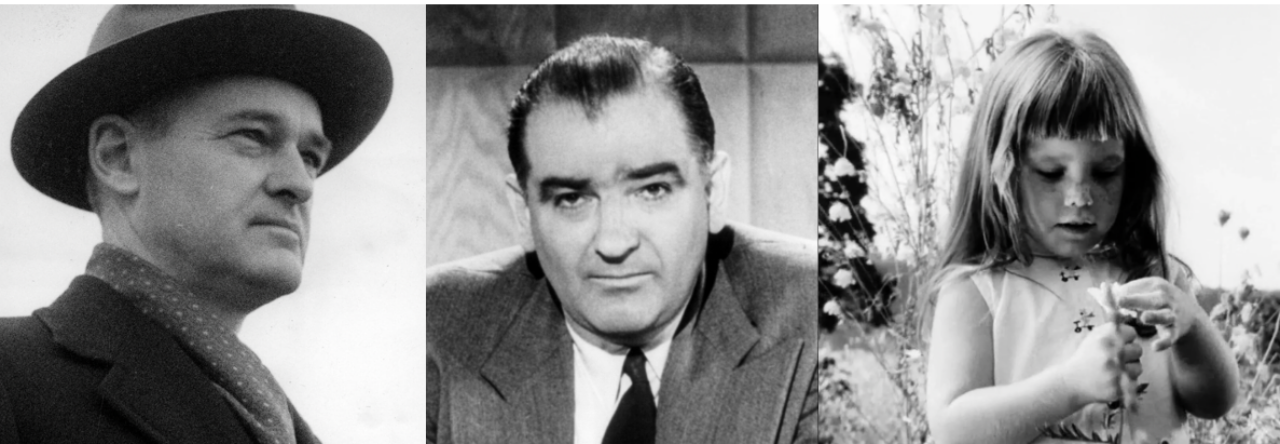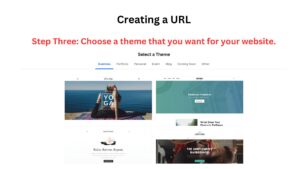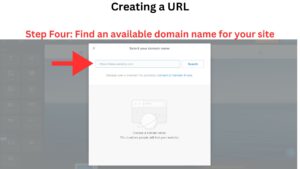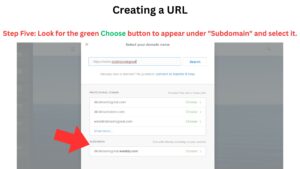ESSAY Due April 29 by 5pm // WEBSITE Due May 9 by 5pm
The highlight of this semester will be a website project that students will undertake to explain the contributions of an American figure in shaping or illustrating aspects of the Cold War era. Subjects might include diplomats or politicians who helped define the period 1945 to 1991, or ordinary Americans whose lives were shaped by Cold War developments in that timeframe. By Monday, April 29, students must submit an 8- to 10-page essay on their subject, relying on a range of primary and secondary sources, and employing Chicago-style footnotes. All essays should address some key element of Cold War historiography or interpretation. Papers will receive provisional grades that will be updated following submission of the final website project. By Thursday, May 9, students should revise this essay and transform it into a website on the free platform Weebly. Each website should include an array of properly credited and captioned images as well as at least one embedded short video (about 1 to 2 minutes). Projects will be graded on depth of analysis, research and design effort, and quality of prose. Late research submissions will be penalized up to 5 points per day.
All submissions by email (either with Word doc or PDF attachment or by email URL link)
Additional guidelines –Draft Essay (4/29/24)
NOTE: Provisionally graded essays will NOT be penalized for lateness, but students must communicate clearly if they miss the 4/29 deadline and they must submit NO LATER than 5/3 or face penalties on their final project grade
- Students should consult with Prof. Pinsker over email as they make decisions about choosing their Cold War subjects and also about transforming their profile paper into an effective teaching website.
- Prof. Pinsker will review full or partial drafts until day before deadline for either essay or website
- Please open your paper with a descriptive title and your name (byline).
- Make sure to address a question and devise a thesis statement that can be effectively argued in a short paper. Consult the Methods Center handout on How to Write a Thesis Statement
- Research effort is key for this paper. Make sure to consult a thoughtful array of both primary and secondary sources. To get started, look carefully at Herring’s book (including his footnotes and bibliographic essay) and academic reference sources, such as American National Biography Online (database finder), Office of the State Department Historian, or Congressional Biographical Directory. Then turn to academic secondary sources, such as books via our library catalog or Google Books (but note limitations) or academic journals from our database finder, such as available via JSTOR or America: History and Life.
- Your next research step involves careful primary source research. Use different types of historical newspaper databases from our college subscription services, such as Historical Newspapers (ProQuest). But also make sure to check relevant government document collections, especially FOREIGN RELATIONS OF THE US OR FRUS from the US State Department. But also consult GW National Security Archive and other collections. See our course web guide for further details.
- Organize your essay in a way that respects chronology and historical context.
- Use past tense except when describing modern scholarship
- Avoid first person pronouns, including “our”
- Take to care to evaluate your sources as you deploy them in your essay. See this methods post on Evaluating Sources for a helpful overall framework.
- Don’t underestimate the importance of integrating your quoted evidence with some degree of fluidity. Awkwardly inserting quotations is one of the hallmarks of mediocre undergraduate essays. Consult this handout from the methods center for a range of good tips.
- Also, please guard against plagiarism. Remember our discussion from the very first day of the semester. Never write your own words while looking directly at your sources, especially secondary sources –unless you are quoting them.
- And finally, always remember to proofread your work by printing it out and reading it aloud, slowly. See our methods handout on How to Proofreed [sic]
- Here are three model papers from a different course culled from the Student Hall of Fame that everyone should try to review before writing: Brian Krussell, Bound by the Numbers: Robert McNamara (Fall 2009); Moyra Schauffler, Madeleine Albright Profile (Fall 2014) and Becca Solnit, Adlai Stevenson at the UN (Fall 2009).
- Finally, here is a sample outline of a typical short biographical paper:
- Introduction (1-2 pps)
- Striking quotation or narrative vignette + clear thesis statement
- Engage readers and provide analytical framework
- Background: To Cold War (2-3 pps)
- Biographical and period insights narrating story through Cold War
- Rely on secondary sources here
- Cold War Case Study (2-3 pps)
- Focus on subject’s role in key Cold War episode or theme
- Show primary source research effort here
- Analysis / Historiography (2-3 pps)
- Explain how historians differ when analyzing this figure / episode / theme
- Rely on secondary sources here
- Conclusion (1-2 pps)
- Return to (and refine) opening analysis
- Explain significance
- Introduction (1-2 pps)
WEB PROJECTS
Teaching websites can be organized with an essential question or theme rather than a thesis statement (as in a standard paper).
-
- EXAMPLE THESIS: “Robert Kennedy’s participation in ExComm meetings during the Cuban Missile Crisis went far beyond the customary role of an attorney general, raising profound questions about the Kennedy brothers’ commitment to orderly national security decision-making.”
EXAMPLE QUESTION: “Who deserved to be ‘in the room’ with President Kennedy during the Cuban Missile Crisis?”
- EXAMPLE THESIS: “Robert Kennedy’s participation in ExComm meetings during the Cuban Missile Crisis went far beyond the customary role of an attorney general, raising profound questions about the Kennedy brothers’ commitment to orderly national security decision-making.”
Once again, students should employ a variety of primary and secondary sources, but now benefiting from the online platform, they should also strive to find ways for providing full-text access to those primary sources whenever available.
- Consider using the course web guides as models for sharing access to sources
Most important, students should also strive to engage classroom audiences with a host of visual and multi-media tools such as timelines, maps and podcasts, in addition to the required short video.
Students may also embed and curate multi-media elements from outside sources, but they must take care to credit and caption those sources properly.
- Credits offer short acknowledgments of sources (Library of Congress) or (House Divided Project at Dickinson College). Captions provide brief descriptions of images or multi-media.
All text content at the student-produced websites should be original and cited with Chicago-style footnotes.
- Don’t forget your Chicago-style rules. See this methods handout on How to Use Footnotes and consult as needed with the library’s Chicago-style guide, but make sure to use sample footnote models for formatting and NOT bibliography examples.
Students should submit a link to their website by email to Prof. Pinsker. Late projects will be penalized up to 5 points per day.
Weebly guidance
- Building websites in Weebly is easy –and free (even though the platform is now part of SQUARE. Just make sure you sign up for the free version of the site and pick the “subdomain” URL that allows for Weebly branding (e.g. 1876election.weebly.com). NOTE: sometimes your desired subdomain URL is not available. Just keep trying.
- PRIVACY: Your Weebly sites can be kept essentially private if you change the SEO settings on your web pages to “Discourage Search Engines.”
- All websites should have at least three main content pages: e.g. Biographical background, Diplomatic Episode or Main Theme, Career Significance. All sites should also have a separate home page that describes both the nature of the project (biographical subject) and the author (with grad year and major) and a mention of this class and semester. There is no minimum word count, but most sites should contain the rough equivalent of the 8-10 page profile paper combined with supporting images, one embedded original short video and perhaps some additional multi-media resources (original or external).
Getting Started in Weebly with Five Easy Screenshots
- Step 1: Sign Up
- Step 2: Personal Weebly
- Step 3: Choose Theme
- Step 4: Find Name
- Step 5: Chose Subdomain
Model Sites
Finally, here are some model student-produced Weebly sites culled from the Student Hall of Fame. Take special notice of how these students organized their content toward teaching goals. Also, pay attention to the ways they employed embedded images, multi-media resources, and hypertext links to primary sources.
- Sarah Aillon, Allen Dulles (Spring 2019)
- Charlotte Goodman, Henry Wallace (Fall 2020)
- Jack Kimbrell, George Kennan (Spring 2023)
- Nadia Shahab Diaz, Wild Bill Donovan (Fall 2020)
Videos
- Here are some student models to rely upon for the companion short biographical videos:
- Roger Brooke Taney (Sarah Goldberg, 2016)
- Moncure Conway (Sam Weisman, 2017)
- Another legitimate approach for the video companion is to create a reading from one of your subject’s speeches or writings:
- Jordyn Ney, Sojourner Truth’s woman’s rights speech (1851) (Summer 2021)
- For detailed written instructions on producing these videos in the free online platform WeVideo, please see this page. And below is a short video tutorial on using WeVideo. Please note that WeVideo has paid options, but anyone in this course can sign up for a free account and have more than enough time (up to 5 minutes per month) for this assignment (which requires about 1 to 2 minutes of video). For those who want to use other video production software, such as iMovie or Windows MovieMaker, please consult those video tutorials at the House Divided YouTube channel –but also please remember that you will have to then post your video at your own YouTube channel before you can embed it at the WordPress course site.
Other Multi-Media Tutorials





